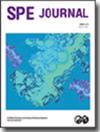Thermal Fracture Simulation in Depleted Gas Field Carbon Capture and Storage: Implications for Injectivity and Flow Assurance
IF 3.2
3区 工程技术
Q1 ENGINEERING, PETROLEUM
引用次数: 0
Abstract
CO2 injection into depleted gas fields causes long-term cooling of the reservoir. Therefore, even if injection pressure stays below the fracture initiation pressure, the cooled volume still creates an extensive stress disturbance that can induce the propagation of large fractures over time. The enhanced injectivity after the onset of this thermal fracturing might jeopardize injection operations due to the risk of hydrate plugging in the injection well caused by the combination of low pressure and low temperature, and large fractures may also increase the risk of loss of containment. Modeling the fracture evolution provides an estimate of the magnitude and timing of these effects. In this study, commercial compositional reservoir simulation software capable of modeling the physical phenomena associated with CO2 injection into depleted natural gas reservoirs has been used. These encompass CO2 mixing with natural gas, water vaporization, thermal effects, and geomechanics. The finite-element geomechanics module used “two-way” coupling, which computes pressure and temperature in the flow simulation module, transmits this information to the geomechanics module to update stress and strain parameters, and uses these parameters to adjust porosity and permeability, thereby enhancing the accuracy and reliability of the overall simulation results. The thermal fracture opening is simulated as increased permeability in the fracture domain by using a fracturing criterion based on the effective stress. The fracture simulations were developed in close relation with flow assurance modeling to determine the operational windows that avoid hydrate formation while maintaining the required injection target. Unlike matrix injection, thermal fracturing shows a substantial reduction in injection bottomhole pressure (BHP), reaching 26 000 kPa (260 bar) in a specific scenario. These findings underscore the crucial consideration of cooling effects and thermal fracturing in carbon capture and storage (CCS) operations, particularly in flow assurance studies where well injectivity significantly influences overall outcomes. Due to the intense cooling-induced stress reduction, thermal fractures may propagate uncontrollably, potentially reaching faults within the reservoir. Temperature distributions along boundary faults may differ markedly from matrix flow conditions, highlighting the need to incorporate these effects into geomechanical studies to mitigate risks associated with fault stability during cooling processes.贫化气田碳捕集与封存中的热裂缝模拟:对注入率和流量保证的影响
向枯竭气田注入二氧化碳会导致储层长期冷却。因此,即使注入压力保持在裂缝起始压力以下,冷却后的体积仍然会产生广泛的应力扰动,随着时间的推移会诱发大裂缝的扩展。由于低压和低温的共同作用会造成注水井水合物堵塞的风险,因此这种热裂缝开始后增强的注入能力可能会危及注水井的注水作业,而且大裂缝还可能会增加失去封隔层的风险。建立裂缝演化模型可估算这些影响的程度和时间。在这项研究中,我们使用了商业成分储层模拟软件,该软件能够模拟与向枯竭天然气储层注入二氧化碳相关的物理现象。这些现象包括二氧化碳与天然气的混合、水汽化、热效应和地质力学。有限元地质力学模块采用 "双向 "耦合,在流动模拟模块中计算压力和温度,将这些信息传输到地质力学模块以更新应力和应变参数,并利用这些参数调整孔隙度和渗透率,从而提高整个模拟结果的准确性和可靠性。通过使用基于有效应力的压裂准则,将热裂缝开裂模拟为裂缝域渗透率的增加。压裂模拟与流量保证建模密切相关,以确定避免水合物形成的操作窗口,同时保持所需的注入目标。与基质注入不同的是,热压裂大大降低了注入井底压力(BHP),在特定情况下达到 26 000 千帕(260 巴)。这些发现突出表明,在碳捕集与封存(CCS)作业中,尤其是在油井注入率对总体结果有重大影响的流动保证研究中,对冷却效应和热压裂的考虑至关重要。由于强烈冷却导致应力降低,热裂缝可能会不受控制地扩展,有可能到达储层内的断层。边界断层沿线的温度分布可能与基质流动条件明显不同,这就需要将这些影响纳入地质力学研究,以降低冷却过程中与断层稳定性相关的风险。
本文章由计算机程序翻译,如有差异,请以英文原文为准。
求助全文
约1分钟内获得全文
求助全文
来源期刊

SPE Journal
工程技术-工程:石油
CiteScore
7.20
自引率
11.10%
发文量
229
审稿时长
4.5 months
期刊介绍:
Covers theories and emerging concepts spanning all aspects of engineering for oil and gas exploration and production, including reservoir characterization, multiphase flow, drilling dynamics, well architecture, gas well deliverability, numerical simulation, enhanced oil recovery, CO2 sequestration, and benchmarking and performance indicators.
 求助内容:
求助内容: 应助结果提醒方式:
应助结果提醒方式:


